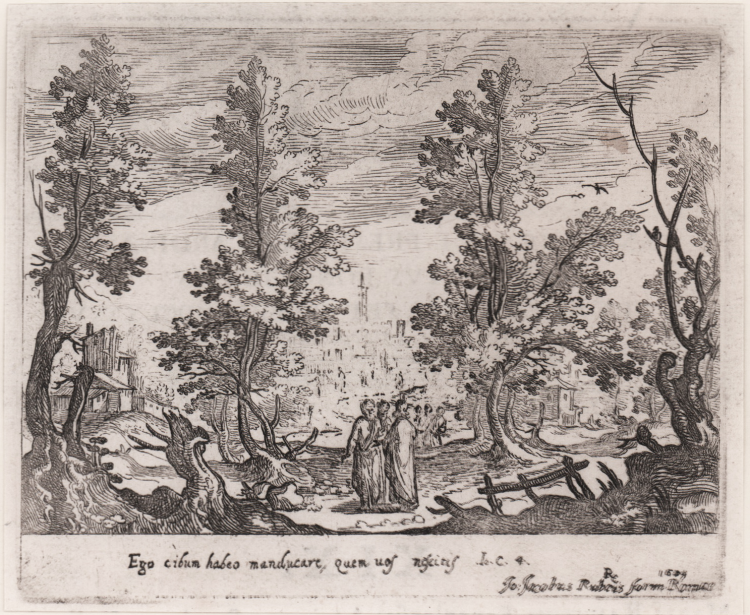



| Reference: | S39246 |
| Author | Remigio CANTAGALLINA |
| Year: | 1609 |
| Measures: | 115 x 95 mm |


| Reference: | S39246 |
| Author | Remigio CANTAGALLINA |
| Year: | 1609 |
| Measures: | 115 x 95 mm |
Etching, 1609, signed with monogram lower right in the image.
Good example, of the second state with De Rossi’ address, printed on contemporary laid paper, very good condition.
Remigio Cantagallina, a landscape designer originally from Borgo San Sepolcro and active in Florence in the first half of the 17th century, is known to critics above all as one of the most productive followers of Giulio Parigi, the brilliant and versatile artist who succeeded Buontalenti as engineer. Like his predecessor, Parigi organized informal didactic meetings in his own home, which we know from a famous description by Baldinucci. This school, or should we say “academy” was attended by a heterogeneous public of artists and amateurs, eager to educate themselves in the disparate fields of activity of the master. In this singular environment was formed a group of artists who practiced landscape drawing imitating the precious and calligraphic style of the master. The most famous names - above all Callot and Stefano della Bella - were flanked by a galaxy of petits maitres that only the critical efforts of the last decades have gradually made it possible to distinguish in such a framework of studies the first reconnaissance of Cantagallina's work. Baldinucci himself, after all, includes Remigio and his two brothers [Antonio and Giovan Francesco] in a long list of frequenters of the Accademia.
One of the most important biographical testimonies of Cantagallina's activity is the notebook of one hundred and five sheets (Royal Library of Brussels), in which the artist wrote down, from time to time, the visions of landscapes and cities he visited during his journey in the Netherlands. It is a real travel notebook of the artist, who, like many Dutch travelers in Italy, faithfully depicted the places he visited (especially Brussels and its surroundings), gathering an extraordinary nucleus of views of the countryside and the main Flemish cities. In the pages of his notebook Remigio also lingered to portray fellow travelers, scenes of daily life, manufacturing installations, or anything else that might attract his curiosity. The series includes about thirty dated sheets, all between 1612 and 1613, and numerous topographical captions. (cf. S. Rinaldi, Il Viaggio nelle Fiandre di Remigio Cantagallina in Annali della Scuola Normale Superiore di Pisa. Classe di Lettere e Filosofia, Vol. 3, No. 2, (2011), pp. 465-495).
Remigio CANTAGALLINA (Borgo San Sepolcro, 1582 circa; Florence, 1656).
|
Italian etcher and draughtsman. He did not study at the ‘academy’ of Giulio Parigi in Florence, as has been claimed, although he did collaborate with the architect in 1608 when he engraved prints of two of Parigi’s theatre sets. His first documented work is from 1603, the date of a series of landscape etchings. Northern influences in his early prints can be traced to Paul Bril, but his way of creating perspective by the intensification of shadow is reminiscent of Antonio Tempesta. It is significant that Cantagallina was one of the first artists to abandon the late-Mannerist vision of nature as fantastic and frightening for a genuine interest in themes from daily life. Among his most notable drawings are the splendid Village Piazza and the large View of Siena (Florence, Uffizi). In 1612–13 he was in the Netherlands, where he produced such detailed drawings as the Palace of Brussels and Sulphur-making at Franc Mont (both Brussels, Musées Royaux B.-A.). Some of his etchings also are known: the Death of St Francis (1605); Bona, City of Barbary (1607); four etchings on biblical subjects (1609); a series of 14 landscapes (1627; London, BM); and 12 undated landscapes (Vienna, Albertina). His last known engraving dates from 1635, a Landscape with Travellers that is notable for the delicacy of its execution and for the masterly handling of space. The latest drawing (Florence, Uffizi) is dated 1655.
|
Remigio CANTAGALLINA (Borgo San Sepolcro, 1582 circa; Florence, 1656).
|
Italian etcher and draughtsman. He did not study at the ‘academy’ of Giulio Parigi in Florence, as has been claimed, although he did collaborate with the architect in 1608 when he engraved prints of two of Parigi’s theatre sets. His first documented work is from 1603, the date of a series of landscape etchings. Northern influences in his early prints can be traced to Paul Bril, but his way of creating perspective by the intensification of shadow is reminiscent of Antonio Tempesta. It is significant that Cantagallina was one of the first artists to abandon the late-Mannerist vision of nature as fantastic and frightening for a genuine interest in themes from daily life. Among his most notable drawings are the splendid Village Piazza and the large View of Siena (Florence, Uffizi). In 1612–13 he was in the Netherlands, where he produced such detailed drawings as the Palace of Brussels and Sulphur-making at Franc Mont (both Brussels, Musées Royaux B.-A.). Some of his etchings also are known: the Death of St Francis (1605); Bona, City of Barbary (1607); four etchings on biblical subjects (1609); a series of 14 landscapes (1627; London, BM); and 12 undated landscapes (Vienna, Albertina). His last known engraving dates from 1635, a Landscape with Travellers that is notable for the delicacy of its execution and for the masterly handling of space. The latest drawing (Florence, Uffizi) is dated 1655.
|